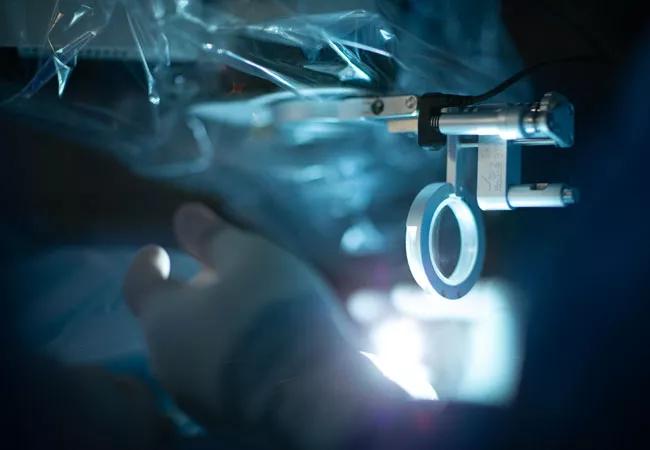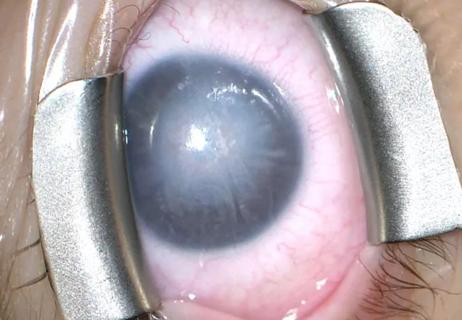Corneal imaging and interpretation play a major role

Twenty years ago, few patients presented for cataract surgery after corneal refractive surgery. “Now, we typically have two or three of these patients per week on our surgery schedule,” says J. Bradley Randleman, MD, a cornea and refractive surgery specialist at Cleveland Clinic Cole Eye Institute.
Advertisement
Cleveland Clinic is a non-profit academic medical center. Advertising on our site helps support our mission. We do not endorse non-Cleveland Clinic products or services. Policy
Refractive outcomes of cataract surgery in this patient population are worse than in patients without prior corneal refractive surgery. Still, the population tends to have high expectations regarding uncorrected visual acuity.
“Someone who had refractive surgery years ago to stop wearing corrective lenses does not want to go back to wearing them,” says Dr. Randleman.
Complicating these high expectations, many cataract surgeons do not perform refractive procedures and may not be aware of recent developments in corneal imaging and interpretation, he notes.
“Corneal imaging and interpretation play a major role in the outcomes of cataract surgery in post-refractive patients,” he says.
These factors prompted Dr. Randleman to head up a review article in Survey of Ophthalmology summarizing evidence-based strategies and guidelines for maximizing surgical success in these patients.
“We felt like there was a great opportunity to provide a collection of practical information,” he says. “Our goal was to offer a guide for busy cataract surgeons who are wanting to better understand corneal imaging and its use in patients with prior refractive surgery.”
Comprehensive corneal imaging before cataract surgery is critical in patients who have had refractive surgery. This imaging helps determine a patient’s refractive surgery ablation pattern (myopic or hyperopic), degree of corneal irregularity, higher-order aberration (HOA) profile, and suitability for additional postoperative refractive surgery, if needed — all steps that the review authors recommend when evaluating patients.
Advertisement
Determining the refractive surgery ablation pattern guides the selection of IOL power formula. Corneal topography is often sufficient to reveal corneal curvature patterns, although more subtle ablations may not be as obvious. The authors caution that using only axial curvature maps may result in missing focal extremes and misreading myopic and hyperopic ablation patterns. They recommend using tangential curvature topographic maps to improve accuracy.
Epithelial thickness mapping is also helpful, although it’s unnecessary in some patients. The Gullstrand ratio is another way to determine ablation pattern if corneal topography is unclear.
Corneal imaging also can detect irregular astigmatism and refractive surgery complications such as central islands, corneal haze, decentered ablations and postoperative corneal ectasia, all of which may jeopardize optical quality after cataract surgery.
Accurately predicting IOL power calculations for patients with prior refractive surgery is the biggest challenge. There are multiple formulas available, many included in the widely used American Society of Cataract and Refractive Surgery (ASCRS) online IOL calculator.
“The ASCRS calculator is a great tool that gives you multiple different outcomes from different formulas,” says Dr. Randleman. “However, it does require accurate manual data entry.”
Another study coauthored by Dr. Randleman found that using the Barrett True-K formula built into most biometers is comparable to using multiple formulas in the ASCRS calculator for post-myopic and post-hyperopic eyes.
Advertisement
“It’s as accurate as the ASCRS calculator, if not a little better,” says Dr. Randleman. “We used to look at a lot of different formulas to find the outlier, but that’s no longer necessary.”
HOAs aren’t often an issue for the average patient with no history of refractive surgery, but they can be big issues for patients who have had refractive surgery. Refractive surgery often changes spherical aberration profiles, which can affect contrast sensitivity.
The Survey of Ophthalmology article includes a table that details how to select IOLs based on spherical aberration profiles. For example, aspheric IOLs are best for positive spherical aberration profiles (commonly found after myopic correction). Spheric IOLs are best for negative spherical aberration profiles (commonly found after hyperopic correction).
The article also discusses managing astigmatism in cataract surgery patients to optimize their satisfaction and quality of vision. Toric IOL implantation and astigmatic keratotomy have been effective in some patients.
Considering the significance of the advent of presbyopia-correcting lenses in cataract surgery, these options also are discussed, including pseudophakic monovision, light adjustable IOL, trifocal IOL, extended depth-of-focus IOL and small-aperture IOL.
Dr. Randleman says determining candidacy for presbyopia-correcting lenses in patients with prior refractive surgery is especially important because, as noted previously, most patients are particularly motivated to reduce their reliance on glasses or contacts. The need for accuracy also is increased in these patients.
Advertisement
“You’ve got to be better with your calculations and your final target, as these patients are more likely to need a follow-up treatment,” he says.
Patients often ask if they can have another refractive surgery if needed after cataract surgery.
“The only way to answer that question is to do a screening and evaluation prior to cataract surgery,” says Dr. Randleman. “It’s much better to answer the question ahead of time rather than after cataract surgery, when you may find that the patient is not a candidate for repeat corneal refractive surgery.”
As advancements in diagnostics, IOL options and IOL power formulas continue, there’s much more to learn about their impact on patients with a history of refractive surgery.
“Preoperative evaluation of patients who have had refractive surgery is more complex than in patients who haven’t had refractive surgery,” concludes Dr. Randleman. “We must continue to recognize and address the differences in these two patient populations.”
Advertisement
Advertisement

30% of references generated by ChatGPT don’t exist, according to one study

A look at emerging technology shaping retina surgery

A multitude of subspecialities offer versatility, variety

Cole Eye Institute imaging specialists are equal parts technician, artist and diagnostician

Novel use of tPA reduces fibrin response in the eye

Registry data highlight visual gains in patients with legal blindness

Prescribing eye drops is complicated by unknown risk of fetotoxicity and lack of clinical evidence

A primer on MIGS methods and devices